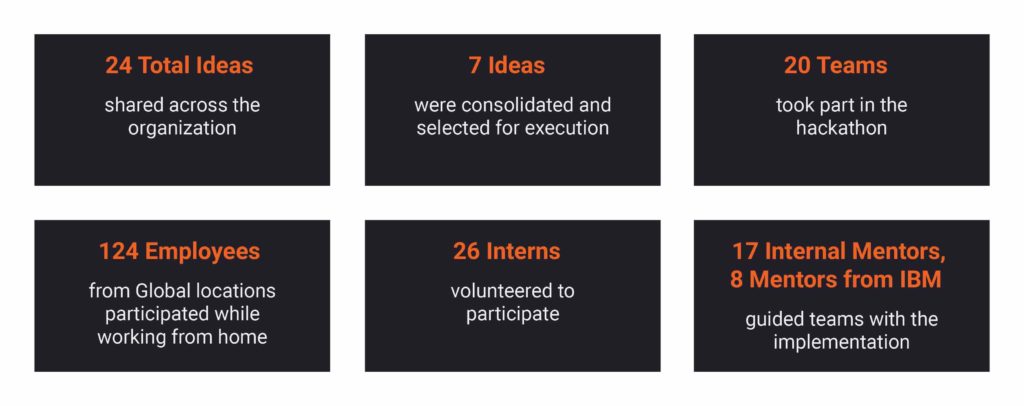We believe strongly in supporting the communities in which we operate and supporting positive change. Since 2018 we have participated in Call for Code, a global initiative created by David Clark Cause with founding partner IBM as the largest tech-for-good challenge of its kind.
Organizing Persistent Hackathon for Call for Code 2020 was a novel experience. Due to the COVID-19 pandemic, all team members were working remotely, across multiple locations. In the past events, team formation was usually limited to a single co-located group. This year, the teams were able to work remotely across different functional teams and locations. In addition, interns were keen to contribute to this effort, which benefited teams in their implementation.
From an organizational viewpoint, planning, coordinating and monitoring were challenging. Extra communication (daily sync between team leads) and collaboration tools (like Teams) were helping in addressing these challenges. It would be important to call out the assistance of different support functions, mentors, architects, judges and the participants, which enabled us to complete this Hackathon successfully.
Organizers: Sandeep Chitnis, Jaidev Karanth and Keyur Shroff
Highlights
Teams were categorized into the following areas
- Remote Education
- Social Distancing
- Community Cooperation
- Crisis Communication
- Machine Learning Framework
- Blockchain
Ideas were evaluated on
- Impact on the victims of the COVID-19 pandemic or the climate change
- Enablement of NGOs/healthcare providers/service providers
- Innovation
- Cost to build the solution
- The time required to build the solution
Congratulations to all the winners!!
1. Solidarity: Federated machine learning to address pandemic treatment
Problem Statement / Challenge: In a pandemic situation, not all hospitals have relevant data or learnings to effectively tackle the situation. Because of legal hassles hospitals are not able to share their data either.
Solution: Federated machine learning model which enables training on decentralized data local to hospitals. Web dashboard for doctors to see triage analysis results.
Impact of the solution: The solution is apt to address the COVID 19 situation by accumulating the tacit information across the geographies. Thinking beyond COVID 19, this design can be used as a building block for treating other epidemics, pandemics, and ailments such as cancer, heart diseases, etc.
Team members: Sagar Revankar, Amogh Tarcar, and Sadashiv Borkar
2. Teacher Assist: Tracking student attentiveness and effectiveness
Problem Statement / Challenge: Due to COVID 19, education is moved online. Teachers find it difficult to track students’ attentiveness and effectiveness.
Solution: A web application TeacherAssist which will ask questions to students based on their attention span. Teacher Dashboards can track the responsiveness and accuracy of the response.
Impact of the solution: Easy to monitor students’ attentiveness & effectiveness by the teacher. Improvement plans can be generated as per the need.
Team members: Arpita Kale, Neha Salgaonkar, MallikarjunaRao Gondela, Harshvardhan Kumar, Tanvi Sambari, Keshav Kirtani, Siddhi Naik, Debashish Chakraborty, Chintan Bhatt, Richa Ojha, Shreyas Gaikwad, and Deepali Gaur
3. Umbra – Safe Shopping Simplified: Maintaining social distancing norms
Problem Statement / Challenge: Having lost a lot of lives in the past few months across the world due to the COVID 19 pandemic, social distancing and using a face-mask has become the need to tackle the spread of this pandemic.
Solution: Integrated multiple IBM services to detect if a person is keeping a proper safe distance as well as taking necessary precautions.
Impact of the solution: Decrease infection spread risk at public places like Offices, Malls, Schools by using computer vision.
Team members: Tirthankar Kundu, Anandan Ramadoss, Tripur Patel, Laxmikant Chaudhary, Shabana Shaikh, Mohanraj Thirumaliah, Nikita Khare, and Mayank Mishra
4. Staying@Home (Special mention): Gamifying and analyzing People@Home data
Problem Statement / Challenge: The most effective action to prevent the virus spread on health emergencies is the lockdown and/or stay at home policy. However, countries are facing challenges to make sure people meet these policies. As a result, there are multiple actions implemented by governments to motivate people to stay at home, which requires public resources that are limited in a public emergency.
Solution: VR Mobile platform to track and analyze Stay@Home behavior. The solution includes different components like Staying@Home mobile app for user interaction, VR Forest for gamification, Staying@Home dashboard for analytics, and geolocation.
Impact of the solution: Help to motivate people to stay at home and help people to get some fun and track their time while staying at home. Quick insights about the results of measures implemented for Stay@Home initiatives to help government and NGOs to optimize public resources utilization
Team members: Roberto Mosqueda, Luis Andrade, Hector Toscano, Jaime Alba, and Guillermo Moreno
Find more content about
hackathon (7) Call For Code (1) Federated Machine Learning (1) Persistent Events (1)







